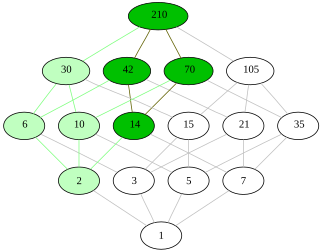In mathematics, a partial functionf from a set X to a set Y is a function from a subset S of X to Y. The subset S, that is, the domain of f viewed as a function, is called the domain of definition or natural domain of f. If S equals X, that is, if f is defined on every element in X, then f is said to be a total function.
In mathematics, a topological space is called separable if it contains a countable, dense subset; that is, there exists a sequence of elements of the space such that every nonempty open subset of the space contains at least one element of the sequence.

In the mathematical field of order theory, an ultrafilter on a given partially ordered set is a certain subset of namely a maximal filter on that is, a proper filter on that cannot be enlarged to a bigger proper filter on
In arithmetic combinatorics, Szemerédi's theorem is a result concerning arithmetic progressions in subsets of the integers. In 1936, Erdős and Turán conjectured that every set of integers A with positive natural density contains a k-term arithmetic progression for every k. Endre Szemerédi proved the conjecture in 1975.
In mathematics, a non-measurable set is a set which cannot be assigned a meaningful "volume". The existence of such sets is construed to provide information about the notions of length, area and volume in formal set theory. In Zermelo–Fraenkel set theory, the axiom of choice entails that non-measurable subsets of exist.
In mathematics, an amenable group is a locally compact topological group G carrying a kind of averaging operation on bounded functions that is invariant under translation by group elements. The original definition, in terms of a finitely additive measure on subsets of G, was introduced by John von Neumann in 1929 under the German name "messbar" in response to the Banach–Tarski paradox. In 1949 Mahlon M. Day introduced the English translation "amenable", apparently as a pun on "mean".
In mathematics, the Fréchet filter, also called the cofinite filter, on a set is a certain collection of subsets of . A subset of belongs to the Fréchet filter if and only if the complement of in is finite. Any such set is said to be cofinite in , which is why it is alternatively called the cofinite filter on .
In number theory, natural density, also referred to as asymptotic density or arithmetic density, is one method to measure how "large" a subset of the set of natural numbers is. It relies chiefly on the probability of encountering members of the desired subset when combing through the interval [1, n] as n grows large.
In mathematics, a syndetic set is a subset of the natural numbers having the property of "bounded gaps": that the sizes of the gaps in the sequence of natural numbers is bounded.
In mathematics, a thick set is a set of integers that contains arbitrarily long intervals. That is, given a thick set , for every , there is some such that .
In mathematics, an IP set is a set of natural numbers which contains all finite sums of some infinite set.
In combinatorics, a branch of mathematics, partition regularity is one notion of largeness for a collection of sets.
In mathematics, ergodicity expresses the idea that a point of a moving system, either a dynamical system or a stochastic process, will eventually visit all parts of the space that the system moves in, in a uniform and random sense. This implies that the average behavior of the system can be deduced from the trajectory of a "typical" point. Equivalently, a sufficiently large collection of random samples from a process can represent the average statistical properties of the entire process. Ergodicity is a property of the system; it is a statement that the system cannot be reduced or factored into smaller components. Ergodic theory is the study of systems possessing ergodicity.
An infinite-dimensional Lebesgue measure is a measure defined on infinite-dimensional normed vector spaces, such as Banach spaces, which resembles the Lebesgue measure used in finite-dimensional spaces.
Ergodic Ramsey theory is a branch of mathematics where problems motivated by additive combinatorics are proven using ergodic theory.
Folkman's theorem is a theorem in mathematics, and more particularly in arithmetic combinatorics and Ramsey theory. According to this theorem, whenever the natural numbers are partitioned into finitely many subsets, there exist arbitrarily large sets of numbers all of whose sums belong to the same subset of the partition. The theorem had been discovered and proved independently by several mathematicians, before it was named "Folkman's theorem", as a memorial to Jon Folkman, by Graham, Rothschild, and Spencer.
Roth's theorem on arithmetic progressions is a result in additive combinatorics concerning the existence of arithmetic progressions in subsets of the natural numbers. It was first proven by Klaus Roth in 1953. Roth's theorem is a special case of Szemerédi's theorem for the case .
Thomas Craig Brown is an American-Canadian mathematician, Ramsey Theorist, and Professor Emeritus at Simon Fraser University.

In the mathematical field of set theory, an ultrafilter on a set is a maximal filter on the set In other words, it is a collection of subsets of that satisfies the definition of a filter on and that is maximal with respect to inclusion, in the sense that there does not exist a strictly larger collection of subsets of that is also a filter. Equivalently, an ultrafilter on the set can also be characterized as a filter on with the property that for every subset of either or its complement belongs to the ultrafilter.
In mathematics, Gowers' theorem, also known as Gowers' Ramsey theorem and Gowers' FINktheorem, is a theorem in Ramsey theory and combinatorics. It is a Ramsey-theoretic result about functions with finite support. Timothy Gowers originally proved the result in 1992, motivated by a problem regarding Banach spaces. The result was subsequently generalised by Bartošová, Kwiatkowska, and Lupini.












